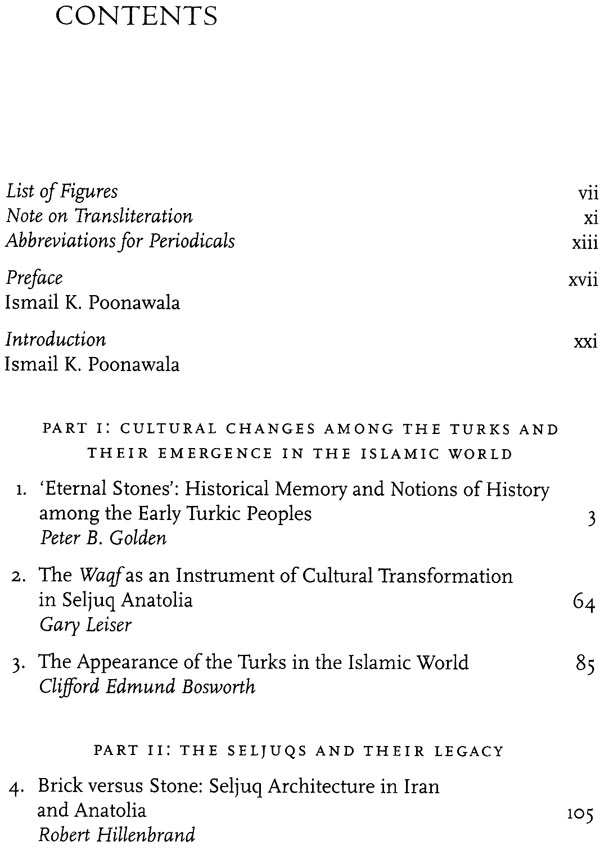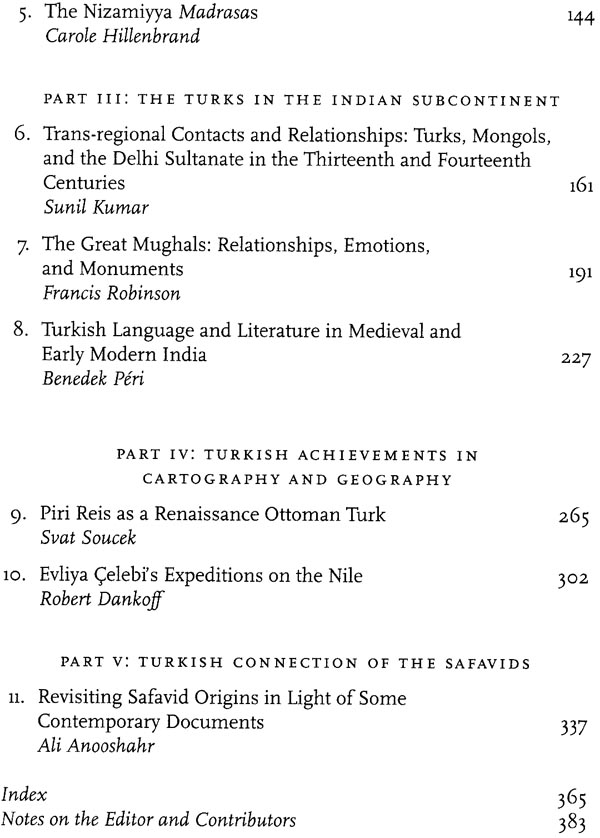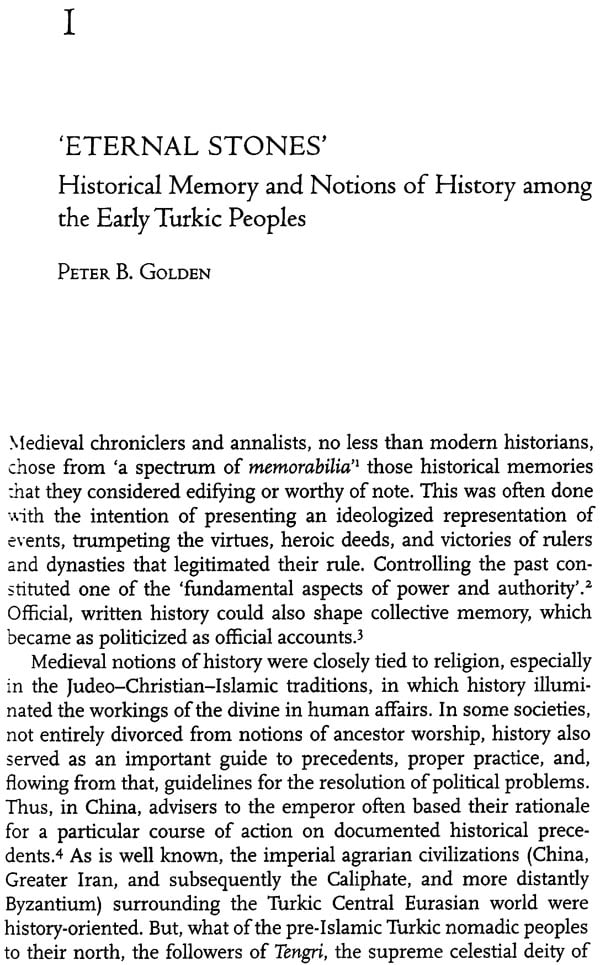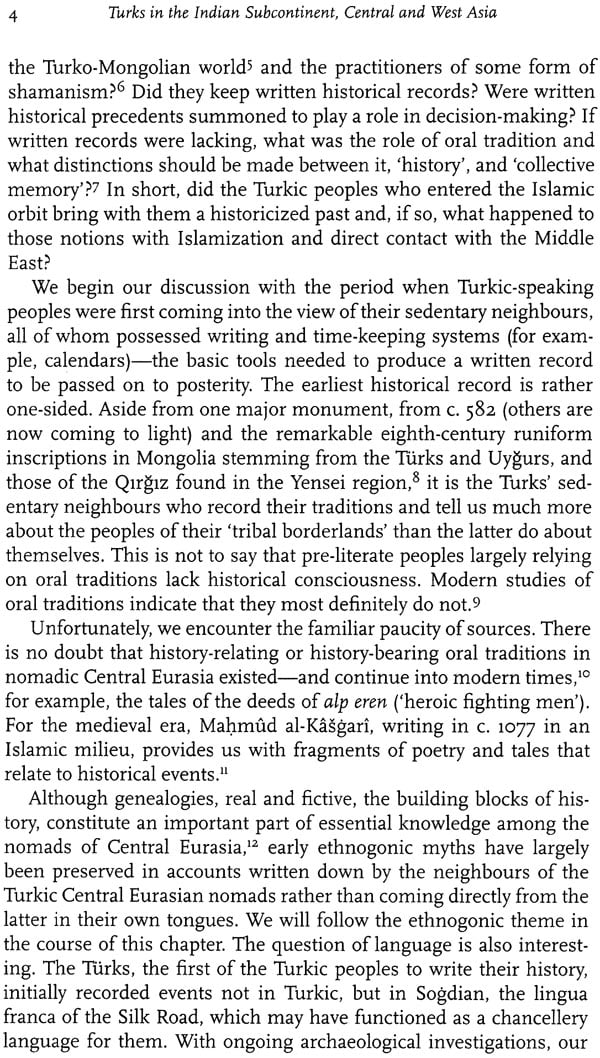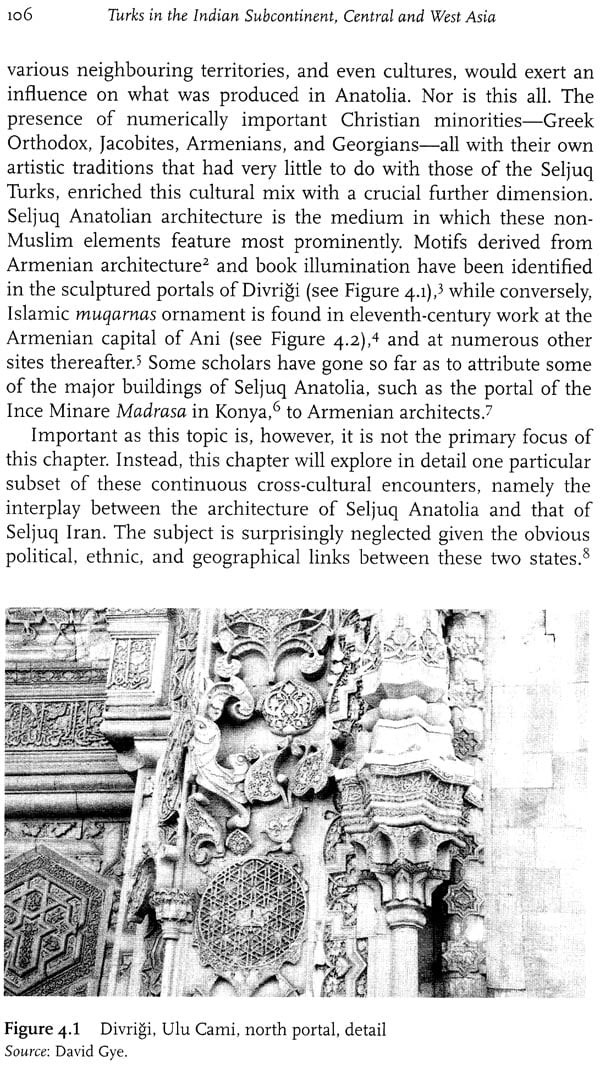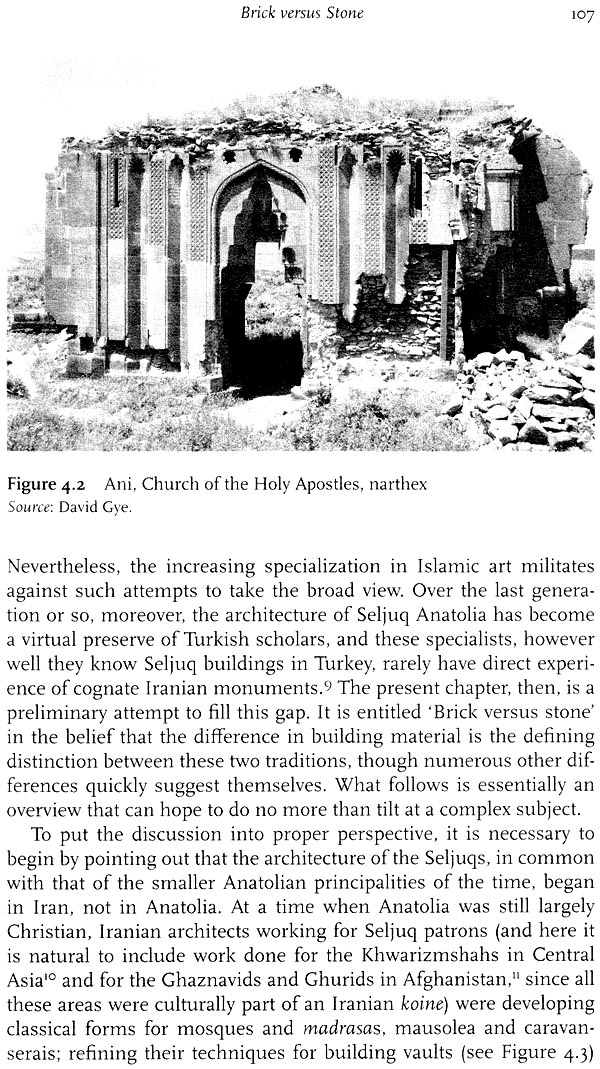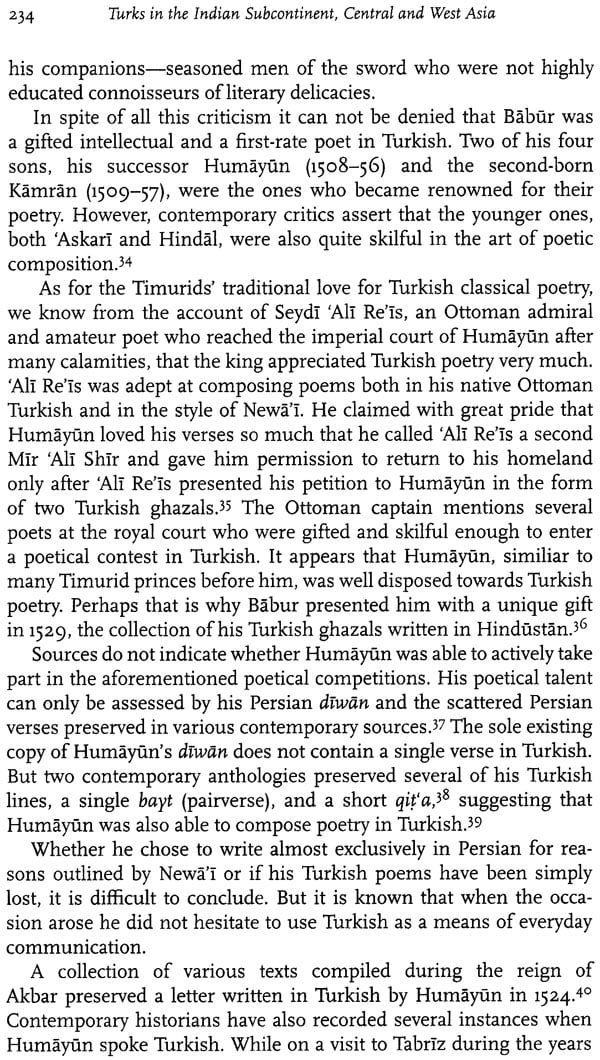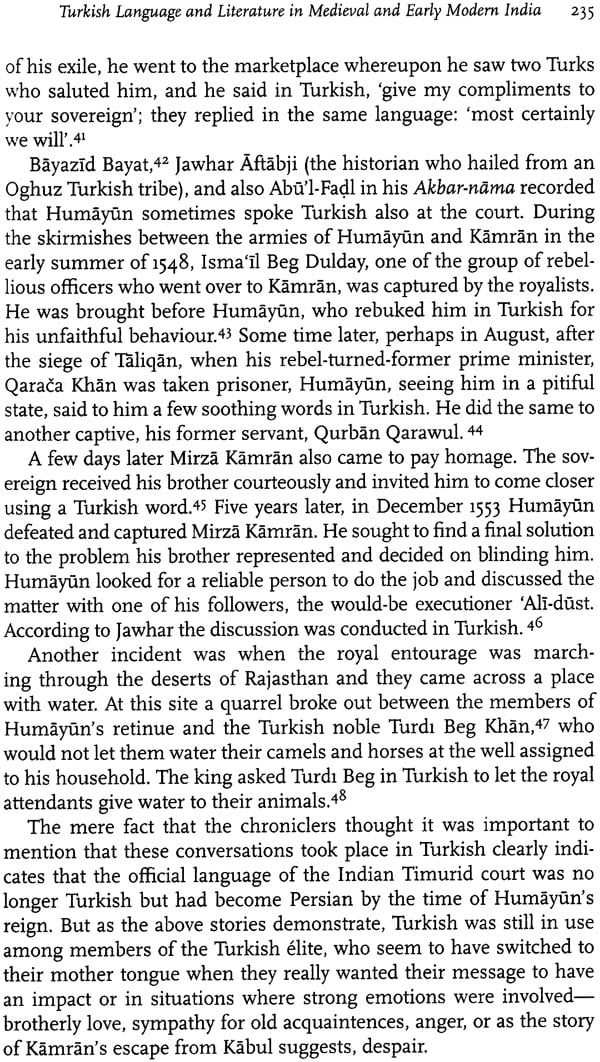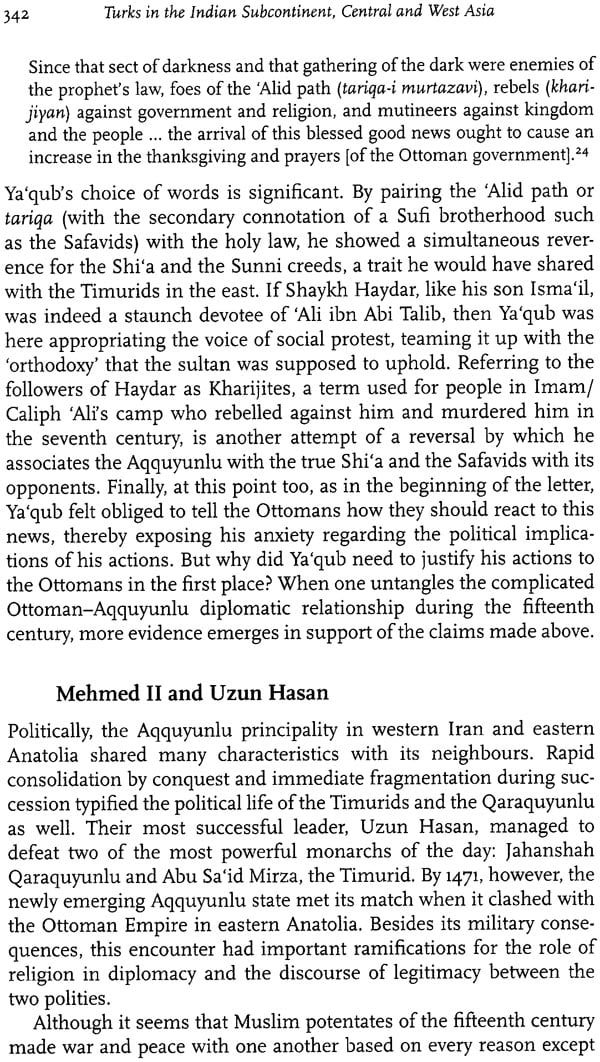
Turks in The Indian Subcontinent, Central and West Asia (The Turkish Presence in The Islamic World)
Book Specification
| Item Code: | NAR988 |
| Author: | Ismail K. Poonawala |
| Publisher: | Oxford University Press |
| Language: | English |
| Edition: | 2017 |
| ISBN: | 9780198092209 |
| Pages: | 412 (36 B/W Illustrations) |
| Cover: | HARDCOVER |
| Other Details | 9.00 X 6.00 inch |
| Weight | 580 gm |
Book Description
For almost a millennium until the beginning of the twentieth century, Turkish rulers and military commanders controlled vast stretches of Islamic lands. While these rulers dominated lands far and wide—from Algeria in the west to Bengal in the east, reaching up to the Volga region in the north and Yemen in the south—Turkish scholars, theologians, jurists, poets, and other literary figures significantly influenced the Islamic world and its culture.
Highlighting the political and cultural history of the Turks—not only within the context of the Indian subcontinent, where they laid the foundation of one of the world’s biggest empires in the form of the Mughal Empire, but also within the context of Central and West Asia—this outstanding work of collective scholarship moves beyond conventional frames of reference and reassesses the contribution of Turks in the shaping of the Islamic world and its civilization.
With contributions from some of the most noted scholars on Islamic history, the chapters in this volume throw light on neglected themes such as the cultural changes among the Turks and their emergence in the Islamic world; their contributions in the fields of cartography and geography; Seljuq architecture and educational system; and the rise of the Safavids and the role of the Turks in the success of their military campaigns.
The present volume is neither a historical nor a political narrative in the usual sense of the words; rather it is a collection of papers delivered at a conference that explored the emergence of the Turkish peoples and their contribution to the historical development of the Islamic world and its civilization. It is, therefore, a work of collective scholar- ship where one finds contributions from some of the best scholars on Islamic history. From their respective fields of specialization, these scholars reassess the contribution of the Turks in the shaping of the Islamic civilization. The scope of the book is not restricted to the original homeland of the Turkish people in Central Asia or present- day Turkey but extends far beyond their geographical homeland to the Indian subcontinent where they dominated for several centuries since the establishment of the Delhi Sultanate and culminating in the Mughal Empire.
Although the contributions of the Turkish peoples to the historical development of the Islamic world and its civilization have been overshadowed by the Arabs and the Persians, their role in the further expansion of Islam and its advancement cannot be underestimated. Students of Islamic history know very well that Arabic, Persian, and Turkish are the three major linguistic components for the study of Islam and Islamic culture. Hence, it will not be out of place to cite Marshall Hodgson from his monumental work The Venture of Islam. The rise of Persian, he writes, had more than purely literary consequences. It served to carry a new overall cultural orientation within Islamdom. While Arabic held its own as the primary language of the religious disciplines and even of natural sciences and philosophy, Persian became, an increasingly significant component of Islamdom, the language of polite culture, and even invaded the realm of scholar- ship. He further observes that more local languages of high culture that later emerged among Muslims, such as Turkish, Urdu, and so on, depended upon Persian as their prime literary inspiration. Henceforth, the Turks also developed nuanced and sophisticated political and cultural traditions. It cannot be ignored that some enduring political and economic institutions introduced in India by the Mughals were developed by the Turks in Central and West Asia.
Turkish rulers and military commanders came to dominate vast stretches of Islamic lands, from Algeria in the West to the Bay of Bengal in the East, from the middle of the Volga region in the North to Yemen in the South, for almost a millennium until the early twentieth century. And their presence was by no means limited to military and governmental aspects; Turkish scholars, theologians, jurists, poets, and other literary figures, all became part of the rich fabric of the Islamic world and its culture. The chapters collected in this volume demonstrate the richness and profoundness of their contribution and how it developed from the emergence of the Turkish people in their Inner Asian homeland to the formation of prominent and power- ful states, such as the Qarakhanids, the Seljuqs of Rum, the mighty Ottomans, the rulers of Turkish origin in Iran (the Safavids) and the Mughals of India, and their cultural and literary achievements. The political process in those empires was deeply influenced by the Turkish presence. Their military organization, ethos, and beliefs pro- vide a common thread that runs through the fabric of those empires. In focusing on their social and cultural activities, several of the chapters bring to light some neglected aspects of Islamic culture.
The chapters are organized into five broad sections as follows:
Part I: Cultural changes among the Turks and their emergence in the Islamic world;
Part II: The Seljuqs and their legacy;
Part III: The Turks in the Indian Subcontinent;
Part IV: Turkish achievements in cartography and geography; and
Part V: Turkish connection to the origins of the Safavids.
The first and the foremost theme treated in Part I is the emergence of the Turks in the Islamic world. It should be noted that the history of early Turks, especially the process of their incorporation in the Islamic world, has been rather neglected by historians. Scholars in this section move beyond conventional frames of reference and investigate issues of identity, consciousness, and historical memory among -the Turks once they entered the Islamic fold. These articles address an important lacuna in our knowledge, and enrich our understanding of the early Turks.
The first essay by Peter B. Golden deals with historical memory and notions of history among the early Turkic peoples. Did the Turkic peoples who entered the Islamic orbit bring with them a historicized past? Were there written historical accounts? If not, what was the role of oral tradition? The author notes that the monuments of Old Turkic have not mentioned a word about their history as such. This leads him to examine various extant inscriptions. The most significant in this respect are the historical accounts in Turkic, written in runiform script on royal tomb complexes of the Uygurs in the eighth century who succeeded the Turks of the eastern empire. Ethnogonic tales, hinted at in the inscriptions, and preserved in Chinese sources, also promoted the miraculous origins of the Ashina royal clan of the Turks, born of a wolf, a theme widespread across Eurasia. According to Ibn Fadlan, the Khazars, the Ashina-ruled successors of the Turks in the westernmost region of their empire, also built tomb complexes. However, they are yet to be discovered. Khazar-generated historical data of the tenth century mentions their genealogical tree going back to the Biblical figure Togarmah, son of Japheth. In his Diwan lughat al-Turk, Mahmiid al-Kashghri, dealing with Islamized and Islamizing Turkic groups, he presents their genealogies in accordance with Islamic and Iranian traditions as descended from Turk, the son of Hapheth (Yafith). Golden concludes his essay by stating that Islam, and Seljuq and Mongol hegemony effaced the older wolf-Ashina Turk traditions and promoted the various Oghuz Khan legends as the starting point of steppe and Turko-Islamic history. Nonetheless, the author notes, the old wolf-Ashina traditions continued among Qipchaq Turkic peoples, especially among those who were relatively latecomers to Islam.
The papers collected in this volume were delivered on the occasion of the nineteenth Giorgio Levi Della Vida Award and Conference in Islamic Studies held by the Gustave E. von Grunebaum Center for Near Eastern Studies at the University of California, Los Angeles, on 18-19 May 2010. The Giogio Levi Della Vida Medal was established by the late Gustave von Grunebaum, the founder and first director of the Center, to honour the memory of this illustrious Italian linguist of Semitic languages for his expertise on the history and culture of the Near East and his contributions to the development of Near Eastern Studies in the United States. He was born in Venice in 1886 to a Jewish family and moved with them to Genoa and then to Rome. He studied at the University of Rome with the Hebraist Ignazio Guidi and graduated in 1909. Thereafter he participated in several expeditions to Cairo, Crete, and Athens. In i911 he returned to Rome and worked with Leone Caetani, historian of the Near East, on the editorial staff of the Annali dell’Islam (Annals of Islam)... From 1914 to 1916, he headed the department of Arabic language and literature at the Eastern University of Naples. During the First World War, he was an army interpreter and then was appointed to the department of Semitic Philology at the University Torino. In 1920 he moved to the University of Rome as a professor of Hebrew and Comparative Semitic Languages. In 1924, he became the president of the National Union of Liberal and Democratic Forces. He was among the twelve Italian university professors who refused to pledge an oath of allegiance to the Fascist leader and regime in 1931. At this time he was assigned by the Vatican Library to catalogue its Arabic manuscripts.
Following the promulgation of the radical laws in Italy in 1939, Giorgio Levi Della Vida fled to the United States. Upon his arrival he was Offered a teaching position first at the University of Pennsylvania, Philadelphia, and then at the University of California in San Diego (UCSD). As a token of his appreciation for the support he received from UCSD, he donated his private library to the latter institution." He returned to Italy in 1945 and was reinstated to his position at the University of Rome, where he taught Islamic history and culture until his retirement in 1959. He died in Rome in 1967 after a brief illness.
The award was established in 1967 to encourage research in the field of Islamic Studies and to honour distinguished scholars in the field. The medal is awarded biennially to an outstanding scholar whose work has significantly advanced the study of the Islamic civilization. The scholar is selected by a committee of international scholars appointed by the Chancellor of the University of California, Los Angeles, under the chairmanship of the director of the Gustave von Grunebaum Center for Near Eastern Studies. The award carries with it the obligation to present in person a formal lecture at the University of California, Los Angeles, as part of a conference. The recipient chooses the theme of the conference, and variations on the theme are presented by a group of senior scholars with well-established international reputations selected by the recipient.
The recipient of the 2010 award was Professor Clifford Edmund Bosworth. He selected the theme "The Turkish Presence in the Islamic World’. He is the author and/or editor of more than twenty books on various topics ranging from the premodern history of the Central and Eastern Islamic lands and of Central Asia, to high Arabic literature. His first book, The Ghaznavids: Their Empire in Afghanistan and Eastern Iran, based on his doctoral dissertation and published in 1964, set a high standard of scholarship and research. It was followed by The History of the Saffarids of Sistan and the Maliks of Nimruz and The Later Ghaznavids: Splendour and Decay. Yet, his other work entitled The Medieval Islamic Underworld: The Banu Sasan in Arabic Society and Literature demonstrates his ability to tackle unusual topics through a critical analysis of literary sources. His English edition of W. Barthold’s Historical Geography of Iran surpasses the prestigious Russian edition. For more than thirty years, he served as an editor for the second edition of The Encyclopedia of Islam. He is also a consulting editor for the Encyclopedia Iranica and co-editor of Iran, Journal of the British Institute of Persian Studies.
Finally, it is my pleasure to thank my student Eric Bordenkircher, wno is about to finish his PhD dissertation in Islamic Studies, for his assistance in editing the chapters and his keen eye for details and consistency. Without his help the volume might not have been as readable as it is now.
**Contents and Sample Pages**
